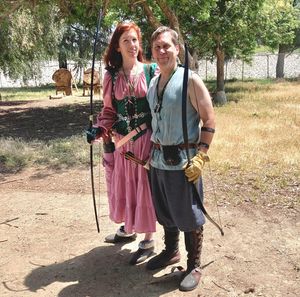House of Stites: Difference between revisions
No edit summary |
No edit summary |
||
| Line 11: | Line 11: | ||
This House considers themselves the, “Growers of Caid.” | This House considers themselves the, “Growers of Caid.” | ||
==History== | |||
The House is named in honor of the family line, Stites. The name traces back to England and Scotland during the 1100s-1600s and comes from the Viking name, “Stoti,” which arrived during the 9th century with the Norse colonization of Scotland. | The House is named in honor of the family line, Stites. The name traces back to England and Scotland during the 1100s-1600s and comes from the Viking name, “Stoti,” which arrived during the 9th century with the Norse colonization of Scotland. | ||
Revision as of 09:06, 7 May 2022
| Photo | ||||
|---|---|---|---|---|
 House of Stites members Meggan of the Angels and Robert the Best practicing target archery in nearby Altavia. | ||||
| Information | ||||
| ||||
| Heraldry | ||||
 Fieldless, two arrows in pale argent, armé, empenné gules, encoché on a cloud vert. |
The House of Stites is an Angel's-based single couple household consisting of Robert the Best and Meggan of the Angels. Their duo Viking-style wedge tent camp is easily recognizable at war with their pennon flags and 10 foot hammock.
The House of Stites enjoys deep time-period play and strives to live as period as possible at events and war. It is not uncommon to not see the House for a period of time, only to then return for nightly drum circles and bardics.
Although an independent household, the House of Stites at times camps with other baronial camps at wars. The House enjoys meeting fellow SCAdians and exploring new skills.
House Purpose
Not only life partners, the House of Stites trains on a regular basis in combat and target archery to defend the Kingdom of Caid. They practice in Altavia and Lyondemere.
This House considers themselves the, “Growers of Caid.”
History
The House is named in honor of the family line, Stites. The name traces back to England and Scotland during the 1100s-1600s and comes from the Viking name, “Stoti,” which arrived during the 9th century with the Norse colonization of Scotland.
The members of House of Stites first met at the place of the death of a Stites ancestor mundanely.
Members
- M'lord Robert the Best
- M'lady Meggan of the Angels